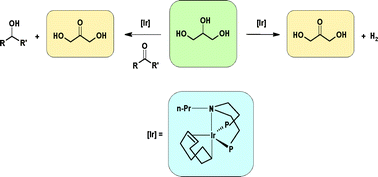Dehydrogenation of glycerol to dihydroxyacetone catalyzed by iridium complexes with P–N ligands
Abstract
The chemoselective

* Corresponding authors
a CNR—Istituto Struttura della Materia, Unità staccata di Trieste, S.S.14, Km 163.5, Basovizza, Trieste, Italy
b INCA (Interuniversity Consortium “Chemistry for the Environment”), Research Unit of Trieste, Italy
c
Dipartimento di Scienze Chimiche, Università di Trieste, Via Giorgieri 1, Trieste, Italy
E-mail:
farnetti@units.it
Fax: +39 040 5583903
Tel: +39 040 5583938
The chemoselective

 Please wait while we load your content...
Something went wrong. Try again?
Please wait while we load your content...
Something went wrong. Try again?
C. Crotti, J. Kašpar and E. Farnetti, Green Chem., 2010, 12, 1295 DOI: 10.1039/C003542D
To request permission to reproduce material from this article, please go to the Copyright Clearance Center request page.
If you are an author contributing to an RSC publication, you do not need to request permission provided correct acknowledgement is given.
If you are the author of this article, you do not need to request permission to reproduce figures and diagrams provided correct acknowledgement is given. If you want to reproduce the whole article in a third-party publication (excluding your thesis/dissertation for which permission is not required) please go to the Copyright Clearance Center request page.
Read more about how to correctly acknowledge RSC content.
 Fetching data from CrossRef.
Fetching data from CrossRef.
This may take some time to load.
Loading related content
